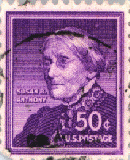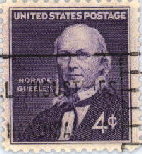Political Ferment Stirs The Nation
In 1829, when Jackson became President, a current of unrest and revolt was coursing through the entire western world. The reform spirit in America, though it had its own sources of support, was thoroughly in harmony with this upsurge. The democratic upheaval in politics exemplified by Jackson's election was merely one phase of the common man's advance toward larger rights and opportunities.
Accompanying the liberal political movement was the beginning of labor organization. In 1835, labor forces in Philadelphia succeeded in reducing the old "dark to dark" work day to a 10-hour day. This marked the beginning of similar reforms in New Hampshire, Rhode Island, Ohio, and the new state of California, admitted to the Union in 1850.
Labor's zeal for humanitarian reform was an essential element in all the progressive movements of the time, and particularly in the struggle for democracy in education. The spread of suffrage had already led to a new concept of education, for clear-sighted statesmen everywhere perceived the danger of universal suffiage among an untutored, even iffiterate electorate. These men - De Witt Clinton in New York, Abraham Lincoln in Illinois, Horace Mann in Massachusetts - were now supported by organized labor, whose leaders demanded free, tax-supported schools open to all children without taint of charity. Gradually, in one state after another, legislative enactment provided for such free instruction. The public-school system became common throughout the northern part of the country. In other parts of the nation, however, the battle for public education would continue for years.
 The reforms that freed men from most of their ancient
letters awakened women to a realization of their unequal position
in society. From colonial times, the unmarried woman had
enjoyed many of the same legal rights as men, but custom required
that she marry early, and with matrimony she virtually lost her
separate identity in the eyes of the law. Women were not permitted
to vote and their education was limited largely to reading,
writing, music, dancing, needlework.
The awakening of women began with the visit
to America of Frances Wright, a
Scotswoman of advanced views. Her public
lectures on theology and women's rights shocked many people.
But her example soon stirred to action such great figures in the
American feminist movement as Lucretia Mott,
a Philadelphia Quaker, Susan B. Anthony, and
Elizabeth Cady Stanton, who braved the contempt of men and of most women
by devoting
their energies publicly to feminism, antislavery, and labor reform.
The reforms that freed men from most of their ancient
letters awakened women to a realization of their unequal position
in society. From colonial times, the unmarried woman had
enjoyed many of the same legal rights as men, but custom required
that she marry early, and with matrimony she virtually lost her
separate identity in the eyes of the law. Women were not permitted
to vote and their education was limited largely to reading,
writing, music, dancing, needlework.
The awakening of women began with the visit
to America of Frances Wright, a
Scotswoman of advanced views. Her public
lectures on theology and women's rights shocked many people.
But her example soon stirred to action such great figures in the
American feminist movement as Lucretia Mott,
a Philadelphia Quaker, Susan B. Anthony, and
Elizabeth Cady Stanton, who braved the contempt of men and of most women
by devoting
their energies publicly to feminism, antislavery, and labor reform.
The feminist leaders were not altogether without friends.
Prominent men like Ralph Waldo Emerson, Abraham
Lincoln,
 and Horace Greeley worked and lectured in their behalf.
Although
the period was one of agitation rather than reform, definite
improvements were brought about. In 1820 Emma Willard
opened a seminary for girls; in 1837, Mount Holyoke, a women s institution of
college rank, was established. Even more venturesome
was coeducation, in which the lead was taken by three Ohio colleges - Oberlin
in 1833, Urbana
in 1850, and Antioch in 1853.
and Horace Greeley worked and lectured in their behalf.
Although
the period was one of agitation rather than reform, definite
improvements were brought about. In 1820 Emma Willard
opened a seminary for girls; in 1837, Mount Holyoke, a women s institution of
college rank, was established. Even more venturesome
was coeducation, in which the lead was taken by three Ohio colleges - Oberlin
in 1833, Urbana
in 1850, and Antioch in 1853.
Meanwhile, in 1848, a women s rights convention, the first in the history of the world, was held at Seneca Falls , New York. Here delegates drew up a declaration demanding equality with the male sex before the law, in educational and economic opportunities, and in voting.
